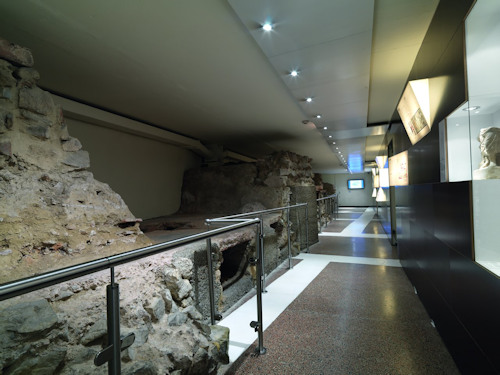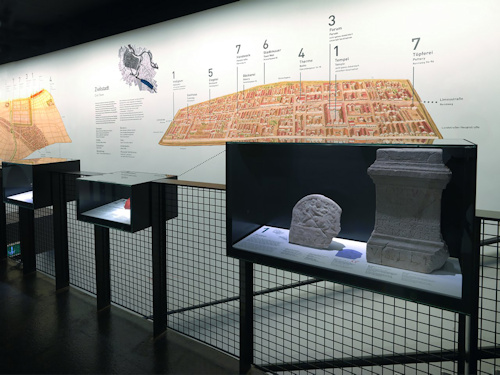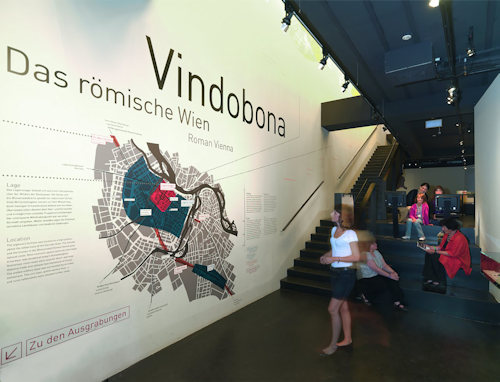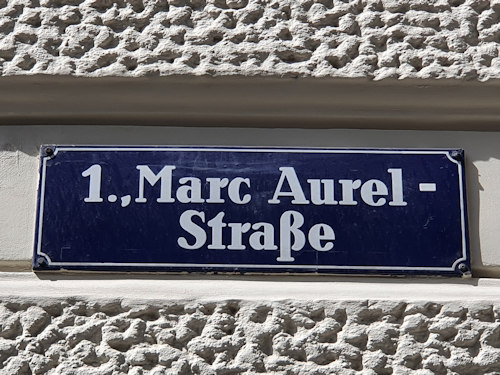It’s one thing to know Roman remains lie beneath parts of Vienna. It’s quite another to grasp just how many: “Vindobona” spread across huge swathes of the modern-day city. The Römermuseum (Roman Museum) has the full story.
- Excellent (and quick) introduction to the Roman fortress and settlements
- Excavations from two officer houses in the actual basement
- Watch the video on water supply (trust me)
- Part of the Wien Museum group of locations
- Join a guided walking tour* in Vienna
- See also:
Vindobona brought to life

(Excavations, education, and entertainment in one)
The first thing that hits you once you enter the Römermuseum is a giant map that shows the extent of the Roman presence compared to today’s Vienna.
That’s when you realise just how big the military camp, military town, and civil settlement must have been.
The fortress alone, for example, housed 6,000 soldiers and headquartered the Twins’ Tenth Legion (Legio X Gemina) for many decades.
The size of this Vindobona (the Roman name for Vienna) reflected the strategic importanc eof the location. The complex lay on the northern border of the empire and formed one of the Danube Limes frontier defences now on UNESCO’s World Heritage List.

(Go down to see the remains of two Roman buildings; photo by Birgit und Peter Kainz © Wien Museum)
Most of Vindobona has long since disappeared under successive layers of urban development. Scholars and archaeologists must spend their lives perpetually frustrated at the treasures that lie just below us but out of reach.
The Roman Museum brings that history back into the light. Literally. The basement floor actually consists of parts of two original building complexes that would have formed the residences of senior officers (tribunes).
The museum’s ground floor examines the legionary fortress, while the top floor covers the military and civil towns and surrounding area.
Large wall maps and associated (small) display cases do an excellent job of describing the layout and structure of the camp and settlements. They also explain the role of key buildings and offer insights into the life and socioeconomics of the area.

(One of the lovely layout maps in the museum; photo by Lisa Rastl and © Wien Museum)
So we learn, for example, of the Praetorium in the fortress (the commander’s home) or the Forum in the civilian town (the administrative centre).
More to the point, the museum makes it clear just how large and developed Vindobona was.
This realisation brings out a tinge of regret that it all disappeared under the boot of the so-called dark ages, with centuries needed for us to begin to recapture the same level of civilisation.
A few relics from excavations and digs add authenticity to the displays. Perhaps the most important is a fragment of a city rights plaque, which reveals privileged municipal rights granted by the emperor (presumably to one of the towns).

(Inside the Roman Museum in Vienna; photo by Birgit und Peter Kainz © Wien Museum)
Remarkably, a highlight proves to be the animated video of how the water supply system worked (stay with me here).
Perhaps you had some vague idea that an aqueduct simply formed a water bridge from a hillside spring down into town? Me, too.
The video reveals the astounding complexity, ingenuity, and engineering skill behind the pipes and towers used to transport and distribute water and run the sewage system.
Tickets & visitor tips
At the time of writing, a standard adult ticket cost €8. A few notes:
- This is not a place for experts seeking in-depth knowledge, but a lovely little explainer for anyone interested in the Roman history of Vienna. Or anyone wanting to know exactly what a Roman military camp would look like and how it would function
- Almost all information inside is provided in both German and English
- Although spread across three floors, the museum is really quite small so won’t take much time to get around
For more Roman history, consider visiting:
- Carnuntum (even bigger than Vindobona) on a short trip out to the east of the city
- One or two other Roman locations and relics in Vienna
- The Wien Museum on Karlsplatz, which features the city’s Roman beginnings in the opening two chapters of the permanent exhibition

(A nod to the city’s Roman past)
The Hoher Markt square outside the museum includes some minor Roman touches:
- One of the neighbouring roads (Marc-Aurel-Straße) bears the name of Emperor Marcus Aurelius, who spent time in Vindobona
- The Ankeruhr opposite the museum has that very same emperor as one of the historical figures that rotates around this large outdoor mechanical clock
(Incidentally, Hoher Markt played a key role as a film set for The Third Man.)
How to get to the museum
The Römermuseum lies in a very central part of Vienna, just up from Stephansdom cathedral.
Subway: nearest stations are Schwedenplatz (U1 and U4 lines) and Stephansplatz (U1 and U3 lines)
Trams/bus: trams don’t pass through this part of Vienna, but the Hoher Markt has its own stop on the 1A and 3A bus lines
Address: Hoher Markt 3, 1010 Vienna | Website
